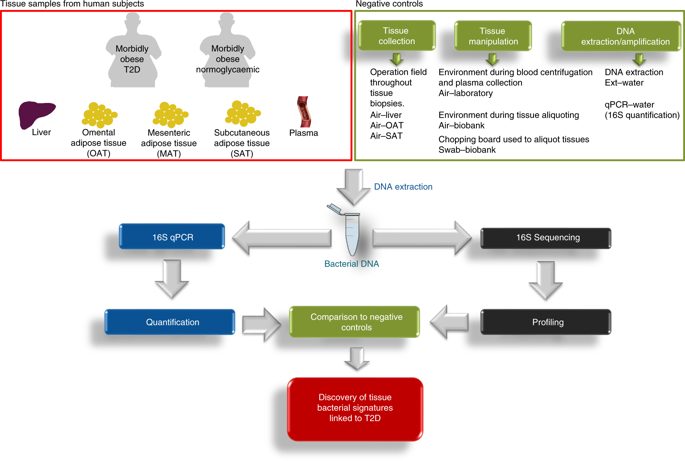Nature Metabolism ( IF 18.9 ) Pub Date : 2020-03-09 , DOI: 10.1038/s42255-020-0178-9 Fernando F Anhê 1, 2 , Benjamin Anderschou Holbech Jensen 1, 3 , Thibault V Varin 1 , Florence Servant 4 , Sebastian Van Blerk 4 , Denis Richard 1 , Simon Marceau 1 , Michael Surette 2 , Laurent Biertho 1 , Benjamin Lelouvier 4 , Jonathan D Schertzer 2 , André Tchernof 1 , André Marette 1

|
Visceral obesity is a key risk factor for type 2 diabetes (T2D). Whereas gut dysbiosis appears to be instrumental for this relationship, whether gut-associated signatures translocate to extra-intestinal tissues and how this affects host metabolism remain elusive. Here we provide a comparative analysis of the microbial profile found in plasma, liver and in three distinct adipose tissues of individuals with morbid obesity. We explored how these tissue microbial signatures vary between individuals with normoglycaemia and those with T2D that were matched for body mass index. We identified tissue-specific signatures with higher bacterial load in the liver and omental adipose tissue. Gut commensals, but also environmental bacteria, showed tissue- and T2D-specific compartmentalisation. T2D signatures were most evident in mesenteric adipose tissue, in which individuals with diabetes displayed reduced bacterial diversity concomitant with fewer Gram-positive bacteria, such as Faecalibacterium, as opposed to enhanced levels of typically opportunistic Gram-negative Enterobacteriaceae. Plasma samples of individuals with diabetes were similarly enriched in Enterobacteriaceae, including the pathobiont Escherichia–Shigella. Our work provides evidence for the presence of selective plasma and tissue microbial signatures in individuals with severe obesity and identifies new potential microbial targets and biomarkers of T2D.
中文翻译:

2型糖尿病会影响人类肥胖症中细菌组织的分隔。
内脏肥胖是2型糖尿病(T2D)的关键危险因素。尽管肠道营养不良对这种关系起着重要作用,但是与肠道相关的信号是否易位到肠外组织及其对宿主代谢的影响仍然不清楚。在这里,我们对病态肥胖个体的血浆,肝脏和三种不同的脂肪组织中的微生物特征进行比较分析。我们探讨了正常血糖个体和与体重指数匹配的T2D个体之间这些组织微生物特征如何变化。我们在肝脏和大网膜脂肪组织中鉴定出具有较高细菌负荷的组织特异性标志。肠道共鸣,还有环境细菌,表现出组织和T2D特异性区室化。T2D信号在肠系膜脂肪组织中最明显,Faecalibacterium与通常机会性革兰氏阴性肠杆菌科的水平升高相反。糖尿病患者的血浆样品也同样富含肠杆菌科,包括致病性埃希氏菌-志贺氏菌。我们的工作为严重肥胖个体中存在选择性血浆和组织微生物特征提供了证据,并确定了潜在的新的微生物靶标和T2D的生物标志物。











































 京公网安备 11010802027423号
京公网安备 11010802027423号